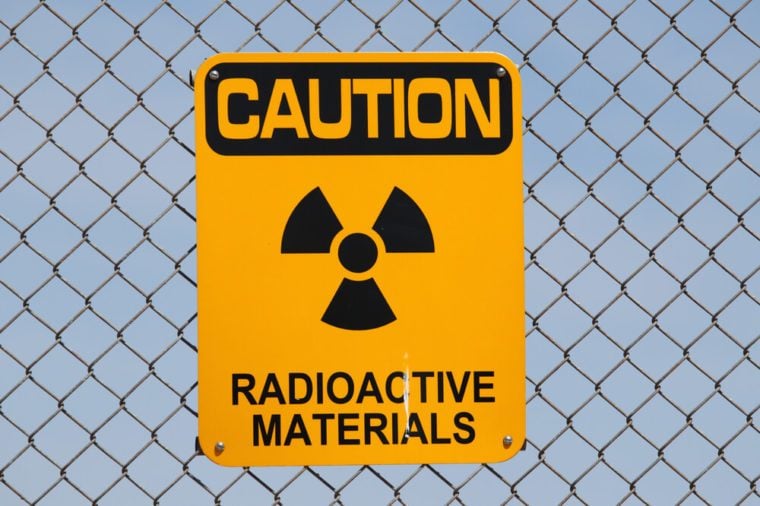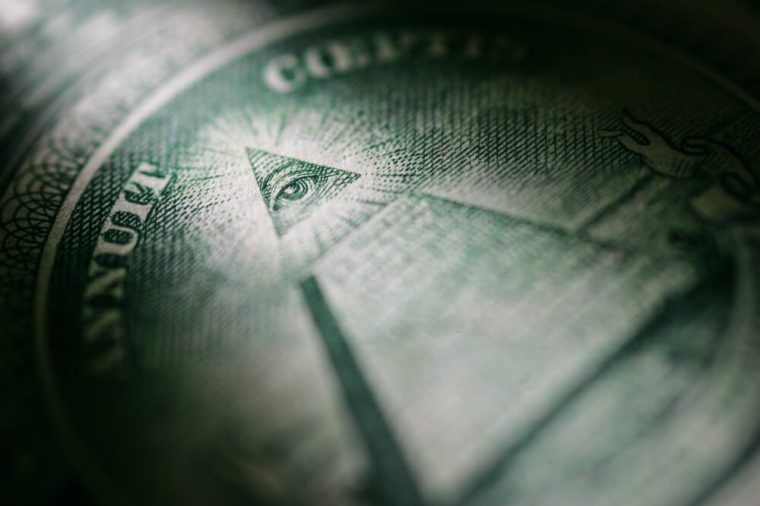12 Conspiracy Theories That Actually Turned Out to Be True
12 Conspiracy Theories That Actually Turned Out to Be True
 Lauren CahnUpdated: Mar. 21, 2020
Lauren CahnUpdated: Mar. 21, 2020
They say the truth is stranger than fiction. That’s no lie: All of these so-called “conspiracy theories” turned out to be legit.

1 / 13NOLIMIT46/GETTY IMAGES
I’m not crazy, you’re all crazy!
Yeah it’s a conspiracy…conspiracy of silence! We’re not saying that every cuckoo-bananas thing you hear is legitimate, we’re just saying that’s the case sometimes. These 12 theories were too crazy to be true—until they weren’t.Volume 0%00:0701:24

2 / 13FSTOCKFOTO/SHUTTERSTOCK
The dead baby project
Laughing at crazy conspiracy theories is good fun—until they turn out to be true. Take the conspiracy surrounding the “Project Sunshine,” for example. In the wake of Hiroshima and Nagasaki, the U.S. government commenced a major study to measure the effects of nuclear fallout on the human body.
Conspiracy: The government was stealing dead bodies to do radioactive testing.
The truth: The government was stealing parts of dead bodies. Because they needed young tissue, they recruited a worldwide network of agents to find recently deceased babies and children, and then take samples and even limbs—each collected without notification or permission of the more than 1,500 grieving families.


3 / 13OLEKSANDRA NAUMENKO/SHUTTERSTOCK
Bad booze
Conspiracy: During Prohibition, the government poisoned alcohol to keep people from drinking.
The truth: Crazy conspiracy theories almost always suggest the government is behind it all—and they were right, again. Manufacturers of industrial alcohol had been mixing their product with dangerous chemicals for years prior to Prohibition. But between 1926 and 1933, the federal government pushed manufacturers to use stronger poisons to discourage bootleggers from turning the alcohol into moonshine. That didn’t stop the bootleggers or their customers, and by the end of Prohibition, more than 10,000 Americans had been killed by tainted booze. Limiting alcohol is a health advice doctors can agree on, but these 11 health controversies and conspiracies still divide people.

4 / 13AP/REX/SHUTTERSTOCK
The first lady who ran the country
Conspiracy: A stroke rendered President Woodrow Wilson incapable of governing, and his wife surreptitiously stepped in.
The truth: Wilson did suffer a debilitating stroke towards the end of his presidency—but the government felt it was in the country’s best interest to keep things quiet. The public didn’t learn about the stroke for months, during which time his wife, Edith Wilson, was making most executive decisions. Despite Mrs. Wilson claiming that she acted only as a “steward,” historians who have analyzed the Wilson term in office confirm that for well over a year, Mrs. Wilson was effectively president.

5 / 13PAVEL KUBARKOV/SHUTTERSTOCK
Government mind control
Conspiracy: The CIA was testing LSD and other hallucinogenic drugs on Americans in a top-secret experiment on behavior modification.
The truth: The program was known as MK-ULTRA, and it was real. The CIA started by using volunteers; the novelist Ken Kesey was one notable subject. But the program heads soon began dosing people without their knowledge; MK-ULTRA left many victims permanently mentally disabled. Don’t miss these 11 controversial medical theories that are actually true.

6 / 13VIPFLASH/SHUTTERSTOCK
The Dalai Lama’s impressive salary
Conspiracy: The Dalai Lama is a CIA agent.
The truth: Perhaps the reason the Dalai Lama is smiling in all those photos has something to do with the six-figure salary he pulled down from the U.S. government during the 1960s. According to declassified intelligence documents, he earned $180,000 in connection with the CIA’s funding of the Tibetan Resistance to the tune of $1.7 million per year. The idea was to disrupt and hamper China’s infrastructure.

7 / 13DAVID MAGNUS/REX/SHUTTERSTOCK
John Lennon was under government surveillance
Conspiracy: The FBI was spying on former Beatle John Lennon.
The truth: Crazy conspiracy theories regarding celebs are always interesting—and this one is most certainly true. Like many counter-culture heroes, Lennon was considered a threat: “Anti-war songs, like “Give Peace a Chance” didn’t exactly endear former Beatle John Lennon to the Nixon administration,” NPR reported in 2010. “In 1971, the FBI put Lennon under surveillance, and the Immigration and Naturalization Service tried to deport him a year later.” Lennon is one of 13 more notable celebrities you didn’t realize were watched by the FBI.

8 / 13SYDA PRODUCTIONS/SHUTTERSTOCK
The government is spying on you
Conspiracy: With the advances in technology, the government is using its vast resources to track citizens.
The truth: In 2016, government agencies sent 49,868 requests for user data to Facebook, 27,850 to Google, and 9,076 to Apple, according to the Electronic Frontier Foundation (the EFF), a major nonprofit organization that defends civil liberties in the digital world and advises the public on matters of internet privacy. You’ve probably also heard that your computer camera could be used to spy on you—here’s the real likelihood someone is watching you through that camera.

9 / 139DREAM STUDIO/SHUTTERSTOCK
Big Tobacco knew that cigarettes caused cancer
Conspiracy: For decades, tobacco companies buried evidence that smoking is deadly.
The truth: At the beginning of the 1950s, research was showing an indisputable statistical link between smoking and lung cancer, but it wasn’t until the late 1990s that Philip Morris, the nation’s largest cigarette maker at the time, even admitted that smoking could cause cancer.

10 / 13ANL/REX/SHUTTERSTOCK
Fake battle, real war
Conspiracy: The Gulf of Tonkin incident on August 2, 1964, was faked to provoke American support for the Vietnam War.
The truth: By the time news reached American ears, the facts surrounding the North Vietnamese attack on the American Naval ship Maddox were already fuzzy. Declassified intelligence documents have since revealed that the Maddox had provided support for South Vietnamese attacks on a nearby island and that the North Vietnamese were responding in kind, according to the U.S. Naval Institute. The event “opened the floodgates for direct American military involvement in Vietnam.” Similarly, there are some crazy aviation conspiracy theories people also believe.

11 / 13JUAN CARLOS LLORCA/AP/REX/SHUTTERSTOCK
There is alien evidence in the American Southwest
Conspiracy: E.T. is buried in the desert of New Mexico.
The truth: This one is real: The Atari video game E.T., the Extra-Terrestrial failed so miserably that the company buried unsold cartridges in a desert landfill. (Wait, what did you think we meant? Real aliens? In New Mexico? Not yet, anyway.)

12 / 13SRUILK/SHUTTERSTOCK
Canada tried to develop gaydar
Conspiracy: The Canada government was so paranoid about homosexuality that it developed a “gaydar” machine.
The truth: It really happened: In the 1960s, the government hired a university professor to develop a way to detect homosexuality in federal employees. He came up with a machine that measured pupil dilation in response to same-sex-erotic imagery; the Canadian government used it to exclude or fire more than 400 men from civil service, the military, and the Mounties. The American government is just as guilty with these 10 secret U.S. government operations, revealed.

13 / 13NAPOCSKA/SHUTTERSTOCK
The Illuminati and the U.S. government
Conspiracy: A secret society that rules the world—the Illuminati—and the U.S. National Security Agency (NSA) are in cahoots.
The truth: We’re here to tell you that a link does, in fact, exist. Of course, that “link” is actually a hyperlink (i.e., an electronic link between two Internet sites). If you type Illuminati backward—Itanimulli—into a web browser, you will land on the NSA website. Click this link if you dare: Itanimulli.com. Rumor has it this elite society includes tons of famous personalities, actors, actresses, and performers. Meanwhile, the royal family is in a league of their own since there are 18 insane conspiracy theories about the royal family. Originally Published:March 20, 2020Lauren Cahn for Reader’s Digest















